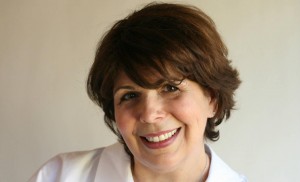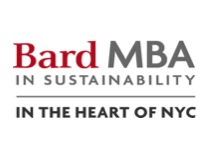Maria Seddio is an executive coach and organizational development consultant who works closely with senior leaders and their organizations to define and put into practice a self-managed model for growing and sustaining their businesses. She uses a strengths-based, solution-focused model that draws on the expertise and natural resilience of people collaboratively working within the context of the business.
 Seddio introduces systems-thinking principles and the concept of conversation as a core business process to focus on the invisible “architecture of talk” that supports every business and change initiative.
Seddio introduces systems-thinking principles and the concept of conversation as a core business process to focus on the invisible “architecture of talk” that supports every business and change initiative.
This Q&A is an edited excerpt from a Sustainable Business Fridays conversation April 24 by the Bard MBA in Sustainability program, based in New York City. This twice-monthly dial-in conversation features sustainability leaders from across the globe. The previous interview was with Jeffrey Amoscato of Shake Shack.
Bard MBA: Maria is the founder of CorpTalk, a communication and strategy leadership program that engages companies, and also the founder of Wash!, a narrative platform for women’s leadership. Maria, would you tell us a bit about your enterprises?
Maria Seddio: CorpTalk is an executive coaching and organizational development firm where we specialize in bringing a narrative change model emphasizing the importance of conversation and systems thinking into organizations. Our goal is to enable whole systems change through participatory management practices and conversations of inclusion. We look at ways in which conversations drive business outcomes. Whether creating a sense of community or shaping organizational culture, the quality of our interactions and the quality of our discussions drive business decisions, enable innovation and shape the direction of the business.
Wash! is analogous work in a nonprofit. Wash! uses the example of women at the riverbank and in backyards, washing clothes, sharing their lives and supporting each other as a metaphor for creating an egalitarian platform to solve problems and build community. The organizing principles and vision for change are similar in both of these enterprises — CorpTalk and Wash! — to get people talking in new ways about things that really matter. In companies, we focus on such things as leadership development, team development, C-level advisement, innovation incubators and culture change initiatives. Through Wash! we target the same objectives via participatory art, dialogues and discussions that are more personal and closer to the bone. We pay particular attention to the ways in which, as women, we are shaping a new paradigm of what it means to lead.
Bard MBA: For you, it is very important to have conversations about inter- and intra-company dynamics and the individual. Why is the emphasis on conversation so important?
Seddio: How does work get done? How does any useful process get created? [Through] qualitative discussions that look at what that process serves, who needs to be involved, what is optimal, how people engage and disengage. The lens we use is that any process is in effect a cumulative conversation that gets mapped and [solidified] in agreements that people make in order to have a disciplined approach to working together to realize a product or provide a service.
At the end of the day, it all comes back to the conversation. Whenever there’s a problem, when there’s something not working, someone has to look at it, open up the conversation and put a pain point on the table — allow the problem to be examined. That can only happen if people are talking.
In addition, we focus on conversation because it’s a resource that is available to all of us — no extra budget required. If you chart your time to see how much of your day is spent on communication, it’s really an extraordinary amount of time — all your time. Even the time that we think we are doing things independent of communication we are communicating, through internal dialogues with ourselves, evaluating, assessing interpreting, remembering direct experience or thinking through and preparing information as if we were in conversation with others. This includes time spent sleeping and dreaming.
Conversations transform how we look at problems and explore potential solutions, but also how we experience and come to know each other. A sincere and difficult conversation with someone — at work or at home or with a friend — can transform the relationship into something much stronger. When we first go into organizations we may experience a kind of generalized low-grade fever because people aren’t having the conversations — they are not willing to risk the conflict. Maybe they tried to speak up in the past and it didn’t work out so they’ve opted into playing it safe and have disengaged.
Bard MBA: What is the buy-in from management and senior leadership when you bring up a conversation-based approach that has potential to transform that feeling of stagnation or ineptitude?
Seddio: When I started CorpTalk, I did a lot of research to determine where there was readiness in the marketplace. Only 20 years ago, to bring up conversation as an approach or change methodology was radical. I think it is more accepted now, although I still don’t think most companies are clear about how to integrate it into their cultures.
I identified companies that were more likely to bring these ideas into their culture by looking at certain cultural criteria. I also identified the attributes of leaders who would be ready to bring this model into their companies and teams. Courage is one of the leadership attributes I identified that is especially worth noting — a willingness to look at the complexity of the business and allow problems to surface, in effect, exposing the organization’s flaws knowing that better solutions emerge as a result.
I have been lucky to work with some extraordinary people, CEOs and senior leaders in major companies who are willing to create more open, democratic, talk-friendly environments — they see the merits of getting everyone’s voice to the table. It is essential that the most senior individuals embrace the model because the model sets the context for healthy, change-oriented dialogue which only happens when people are willing to push the edges of conversations and challenge any decisions that result in suffering.
Those are the conversations that we need to have — conversations that alleviate suffering. Even for people who have advanced skills, they are not easy conversations. When the environment is such that people risk speaking up because they may say something that is outside of the norm, there is a problem. The leader needs to support individuals and teams as they speak up — to manage the model across groups and at a variety levels so that everyone is aligned and skilled at working with such transparency.
Bard MBA: Some people argue that we talk around issues by using dialogue to avoid commitment to action when we have urgent problems to solve. Can you suggest a better way to use this approach proactively?
Seddio: It is always the quality of conversation that matters. We are not promoting just any kind of talk — trivial or redundant conversations are crazy-making. People can talk all day but still manage to avoid real issues. They become frustrated because their conversations don’t produce results and complain that nothing seems to change.
But that is because their conversations lack accountability. A problem that isn’t being solved when the conversation goes in circles is usually a problem of accountability. When people become frustrated with each other or disappointed with efforts that fail or miss the mark, it’s an indicator that the conversation needs to change.
Bard MBA: Some tools that you have developed include the core leadership principles: Calm, Confidence and Competency; as well as the elements that support them: Vision, Values, Voice and Velocity. How do you apply these attributes to produce a meaningful conversation?
Seddio: There are leaders who know how to elevate conversations to transformative levels. They are somehow able to coax people out of their comfort zone, to engage at a more meaningful level. These are the leaders that everybody wants to follow. We did research on leadership attributes that make the biggest difference and ended up with three buckets or behavioral clusters.
The first bucket is Calm — people want to work for a leader who is able to emotionally self-regulate and maintain his or her equilibrium. A good leader is able to focus outwardly on others and on the issues while under pressure.
The second bucket is Competence — we all want to work with people who know what they are doing. Leading means working through uncertainty because inherent in leadership is change. A good leader knows how to work effectively through change.
The third and final bucket is Confidence — research explains that what a person believes is possible is also likely to be realized. Attitudes and beliefs are also contagious so a good leader is able to imbue confidence in others.
Those are the three clusters that we believe make all the difference. They provide evidence of leadership, establish credibility with others and manifest through our interactions and conversations.
The four “V’s” provide a roadmap for developing as a leader. While the roadmap is universal, it is particularly suited for women and men who are looking to introduce a new paradigm or reshape the workplace.
Vision is the ability to paint a new picture, to articulate something new that is true for you and that also inspires others.
Values are important ethical principles that guide your thinking and actions even or especially when the stakes are high.
Voice is the ability to know your mind, to speak to your vision and to advocate for your ideas and principles.
Velocity is the way in which you engage and excite others through inspired conversations and collaborations to accelerate change based on your shared vision and values.
We have complex problems around the globe that need to be addressed urgently. Isn’t it time for us to become more impatient with change? How do we speed things up [and] get out in front of the conversation and not look back? This is what velocity is all about.
Bard MBA: You mentioned deniers of climate change; from a conversational point of view do you have any tips for creating a breakthrough or getting through to them?
Seddio: That’s a tough one and a really good question. Generally the place to start with something that is so opposite, so polarizing, is to say: “I’m here — I don’t agree, but I am here,” and to be clear that you find it important to disagree but also that you are committed to creating a path to a better conversation — that you are not leaving the table. Through these very initial conversations we can keep the door open and get a little further along in a very preliminary way.
Stay the course, help the conversation along and trust it will find its way — and thank you for dedicating your energy and time to something that is so important to all of us.
